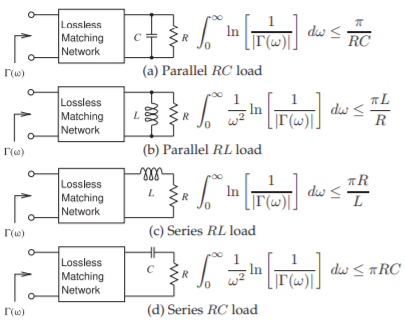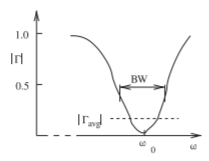7.2: Fano-Bode Limits
- Page ID
- 41144

Figure \(\PageIndex{1}\): Fano-Bode limits for circuits with reactive loads.

Figure \(\PageIndex{2}\): Response looking into matching network used in defining nonintegral Fano-Bode criteria. The bandwidth of the passband (low \(\Gamma\), is BW).
A complex load having energy storage elements limits the bandwidth of the match achieved by a matching network. Theoretical limits addressing the bandwidth and the quality of the match were developed by Fano [1, 2] based on earlier work by Bode [3]. These theoretical limits are known as the FanoBode criteria or the Fano-Bode limits. The limits for simple loads are shown in Figure \(\PageIndex{1}\). More general loads are treated by Fano [1]. The Fano-Bode criteria are used to justify the broad assertion that the more reactive energy stored in a load, the narrower the bandwidth of a match.
The Fano-Bode criteria include the term \(1/ |\Gamma (\omega )|\), which is the inverse of the magnitude of the reflection coefficient looking into the matching network, as shown in Figure \(\PageIndex{1}\). A matching network provides matching over a radian bandwidth BW, and outside the matching frequency band the magnitude of the reflection coefficient approaches \(1\). Introducing \(\Gamma_{\text{avg}}\) as the average absolute value of \(\Gamma (\omega )\) within the passband, and with \(f_{0} = \omega_{0}/(2\pi )\) as the center frequency of the match (see Figure \(\PageIndex{2}\)), then the four Fano-Bode criteria shown in Figure \(\PageIndex{1}\) can be written as
Parallel RC load:
\[\label{eq:1}\frac{\text{BW}}{\omega_{0}}\ln\left(\frac{1}{\Gamma_{\text{avg}}}\right)\leq\frac{\pi}{R(\omega_{0}C)} \]
Parallel RL load:
\[\label{eq:2}\frac{\text{BW}}{\omega_{0}}\ln\left(\frac{1}{\Gamma_{\text{avg}}}\right)\leq\frac{\pi(\omega_{0}L)}{R} \]
Series RL load:
\[\label{eq:3}\frac{\text{BW}}{\omega_{0}}\ln\left(\frac{1}{\Gamma_{\text{avg}}}\right)\leq\frac{\pi R}{(\omega_{0} L)} \]
Series RC load:
\[\label{eq:4}\frac{\text{BW}}{\omega_{0}}\ln\left(\frac{1}{\Gamma_{\text{avg}}}\right)\leq\pi R(\omega_{0}C) \]
In terms of reactance and susceptance these can be written as
Parallel load:
\[\label{eq:5}\frac{\text{BW}}{\omega_{0}}\ln\left(\frac{1}{\Gamma_{\text{avg}}}\right)\leq\frac{\pi G}{|B|} \]
Series load:
\[\label{eq:6}\frac{\text{BW}}{\omega_{0}}\ln\left(\frac{1}{\Gamma_{\text{avg}}}\right)\leq\frac{\pi R}{|X|} \]
where \(G = 1/R\) is the conductance of the load, \(B\) is the load susceptance, and \(X\) is the load reactance. \(\text{BW}/\omega_{0}\) is the fractional bandwidth of the matching network. Equations \(\eqref{eq:5}\) and \(\eqref{eq:6}\) indicate that the greater the proportion of energy stored reactively in the load compared to the power dissipated in the load, the smaller the fractional bandwidth \((\text{BW}/\omega_{0})\) for the same average in-band reflection coefficient \(\Gamma_{\text{avg}}\).
Equations \(\eqref{eq:5}\) and \(\eqref{eq:6}\) can be simplified one step further:
\[\label{eq:7}\frac{\text{BW}}{\omega_{0}}\ln\left(\frac{1}{\Gamma_{\text{avg}}}\right)\leq\frac{\pi}{Q} \]
where \(Q\) is that of the load. Several general results can be drawn from Equation \(\eqref{eq:7}\) as follows:
- If the load stores any reactive energy, so that the \(Q\) of the load is nonzero, the in-band reflection coefficient looking into the matching network cannot be zero across the passband.
- The higher the \(Q\) of the load, the narrower the bandwidth of the match for the same average in-band reflection coefficient.
- The higher the \(Q\) of the load, the more difficult it will be to design the matching network to achieve a specified matching bandwidth.
- A match over all frequencies is only possible if the \(Q\) of the load is zero; that is, if the load is resistive. In this case a resistive load could be matched to a resistive source by using a magnetic transformer. Using a matching network with lumped \(L\) and \(C\) components will result in a match over a finite bandwidth. However, with more than two \(L\) and \(C\) elements the bandwidth of the match can be increased.
- Multielement matching networks are required to maximize the matching network bandwidth and minimize the in-band reflection coefficient. The matching network design becomes more difficult as the \(Q\) of the load increases.

